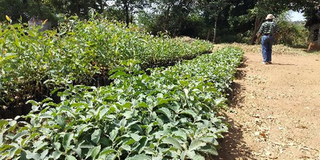You want tree valued for its medicine and timber? Try Mbarau

Terminalia brownii seedlings (mbarao or mwalambe in Kiswahili) at a Kenya Forestry Research Institute (Kefri) nursery in Kitui County. For trees like terminalia brownii, the government needs to intervene with policy directives that strengthen the factors that positively influence their domestication. PHOTO | FILE | NATION MEDIA GROUP
What you need to know:
- Studies have shown that medicine derived from this tree for treatment of bacterial, fungal and viral infections is more potent than conventional drugs by almost three times.
- Its bark produces a yellow-coloured dye that is used in basketry. Its leaves are quality fodder and flowers are good for bee forage.
- Removal of the pericarp and soaking in cold water for 24 hours partially breaks dormancy.
- Among the recommendations, the study called for intercropping the tree with other crops such as green peas, cowpeas, beans, maize and sorghum.
Terminalia brownii (mbarao or mwalambe in Kiswahili) is among trees whose high commercial value has seen them being exploited to near extinction.
It is native to arid and semi-arid regions of Kenya, Eritrea, Ethiopia, Somalia, Sudan, Tanzania and Uganda.
According to Useful Trees and Shrubs for Kenya by Maundu and Tengnas (2005), it thrives well in deep, sandy and loam soils with annual rainfalls of 500 to 1,300 mm.
In Kenya, the tree grows in agro-ecological zones where altitudes range from 0 to 1,400 metres above sea level.
Its other local names include Leh heli (Boni), Biress (Boran), Muuku (Kamba), lbukoi (Samburu) and Orbukoi (Maasai).
Benefits
It is an important drought-tolerant and multipurpose agroforestry species whose potential is underutilised due to poor seed germination.
Its products such as timber, posts, charcoal and carving wood are not available in required quantities for domestic and commercial use.
The wood is used in making furniture, building boats, carvings, beehives, beams and flooring.
The wood from the tree is resistant to termites and other insects, making it especially suited for construction and fencing. Its water extracts are sprayed on wooden houses and furniture to protect them.
Medicine
Studies have shown that medicine derived from this tree for treatment of bacterial, fungal and viral infections is more potent than conventional drugs by almost three times.
It treats many diseases including cough, jaundice, malaria, diarrhoea, wounds, hepatitis, liver cirrhosis, yellow fever, tuberculosis, epilepsy, stomach complaints, colic, eye infections, tonsillitis, typhoid, snake bites and ring worm.
Its bark produces a yellow-coloured dye that is used in basketry. Its leaves are quality fodder and flowers are good for bee forage.
Propagation
The main propagation method is through seeds. However, this is difficult because of poor germination caused by dormancy. Scientists have studied how to improve germination given its value.
One study is titled ‘Promotion of Terminalia brownii in reforestation by development of appropriate dormancy breaking and germination methods in drylands'.
It was carried out in Kitui, Baringo, Makueni and Tharaka-Nithi counties by M.M. Okeyo, G.O Obwoyere, D.L. Makanji, J.W. Njuguna and J. Atieno and published in Global Ecology and Conservation this month. It revealed that the poor germination was probably due to the pericarp, the part of the fruit that encloses the seed. It prevents the seed from soaking in enough moisture and oxygen to break dormancy.
Removal of the pericarp and soaking in cold water for 24 hours partially breaks dormancy.
But even with this, the highest germination percentage the study achieved was 35 per cent. Also noted was a high percentage of diseased fruits with no seed inside that contributes to poor germination.
The Kenya Forestry Research Institute (Kefri) is using these findings to propagate terminalia brownii for sale to farmers.
Dr Albert Luvanda, the regional director of Kefri’s Kitui station, who has studied this tree, says this will make its use sustainable.
Dr Luvanda was the lead researcher in a study, 'Domestication of Terminalia brownii among smallholder farmers in Eastern Kenya: A double hurdle approach’, published in the Journal of Economics and Sustainable Development.
Among the recommendations, the study called for intercropping the tree with other crops such as green peas, cowpeas, beans, maize and sorghum.
Intercropping increases productivity through maximum land utilisation, production factors such as water, light, nutrients and human labour.
For trees like terminalia brownii, the government needs to intervene with policy directives that strengthen the factors that positively influence their domestication.
Mr Wanyonyi is Managing Partner at Storylines Kenya, [email protected]




